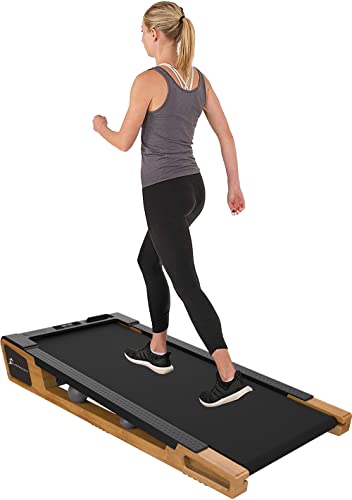A Productive Rant About Walking Pad Non Electric
Exploring the Benefits of Walking Pads: The Non-Electric Choice
In the era of contemporary physical fitness options, where technology reigns supreme and sophistication is frequently connected with electrical machines, a brand-new trend is emerging in practical exercise: the non-electric walking pad. These simple yet effective tools are catching the interest of physical fitness lovers and casual walkers alike.
In this comprehensive guide, we will explore what walking pads are, their benefits, contrasts with standard treadmills, and supply responses to regularly asked concerns.
What is a Walking Pad?
A walking pad is a compact exercise platform designed mostly for walking, running, or light running. Unlike Manual Running Machine which rely on electrical power, non-electric walking pads operate on a manual system. Users propel themselves forward by walking or running, utilizing their own body weight.
Key Features of Non-Electric Walking Pads:
- Compact Design: Most walking pads are light-weight and foldable, making them easy to store and transportation.
- User Controlled: The speed and intensity of the exercise depend upon the user's own effort.
- No Plug Required: Perfect for energy-conscious people, these pads need no power consumption.
- Quiet Operation: A quieter option to electric treadmills, making them appropriate for houses or shared spaces.
Benefits of Using Non-Electric Walking Pads
Utilizing a non-electric walking pad provides a series of benefits. Below are some of the prominent benefits:
Benefit
Description
Cost-Effective
Non-electric models are normally more budget friendly than their electric equivalents, making them available to a more comprehensive audience.
Enhanced Flexibility
Users can walk or jog at their own speed, which is particularly beneficial for novices or those recuperating from injuries.
Space-Saving Design
Due to their compact size, walking pads fit easily in smaller areas, making them ideal for home or office use.
Low Maintenance
With no electrical components, these pads require very little upkeep and are less likely to break down.
Eco-friendly
No electricity suggests no ecological impact from energy consumption, making them a terrific option for eco-conscious consumers.
Comparing Non-Electric Walking Pads to Traditional Treadmills
Function
Non-Electric Walking Pad
Traditional Treadmill
Power Source
Manual (user-powered)
Electric (plugged in)
Cost
Lower in advance cost
Higher initial investment
Size
Compact and portable
Larger, typically fixed
Noise Level
Really peaceful
Can be noisy, depending on motor and use
Customization
Minimal user settings
Substantial settings (speed, incline, programs)
Physical Engagement
Greater intensity and effort required
Simpler to use but might motivate less engagement
How to Use a Non-Electric Walking Pad
Utilizing a non-electric walking pad is uncomplicated. Here's a simple detailed guide:
- Set Up: Place the walking pad on a flat, steady surface area.
- Change the Pad: Ensure that it is at a comfortable position for use— most pads have adjustable angles to tailor the walking experience.
- Warm-Up: Before utilizing the pad, carry out a short warm-up routine, which can include mild extending.
- Start Walking: Step onto the pad and begin walking at a moderate pace. As your speed boosts, you will see the pad moving.
- Screen Your Intensity: Pay attention to your heart rate and how you feel. Change your speed according to your physical fitness level.
- Cool Down: Gradually minimize your speed before stepping off the pad, followed by cooldown stretches.
Best Practices for Using Walking Pads
To maximize the advantages of non-electric walking pads, consider the following tips:
- Incorporate Variety: Alternate between walking and jogging for a full-body exercise.
- Engage Your Core: Maintain excellent posture by keeping your core engaged while using the pad.
- Hydration: Remember to hydrate before and after your exercise.
- Consistency: Aim to utilize the walking pad frequently. Start with 15-20 minutes and slowly increase the period.
Frequently Asked Questions
1. How effective are non-electric walking pads for weight loss?
Non-electric walking pads can be effective for weight loss when utilized regularly in combination with a healthy diet plan. Since they need more effort, they can allow greater calorie expenditure during exercises.
2. What is the weight capacity of most walking pads?
The majority of non-electric walking pads can support individuals approximately 250-300 pounds, depending on the design. Constantly check the manufacturer's specifications for precise information.
3. Are there any advised brands for walking pads?
Some popular brands consist of InMovement, ProForm (manual models), and ECHANFIT, each providing a range of features tailored to varied user choices.
4. Can non-electric walking pads be utilized outdoors?
These walking pads are usually designed for indoor usage. Using them outdoors may expose them to weather that might affect their toughness.
5. How do I store a walking pad?
Many non-electric walking pads are foldable. Simply fold them up and store them in a closet, under a bed, or any convenient area.
Non-electric walking pads use an unique and efficient aerobic workout option that stresses simplicity and accessibility. By permitting users to create their fitness regime without the constraints of power cords and complicated user interfaces, these pads empower people across different fitness levels.
For anyone searching for a budget-friendly, space-saving, and effective option to traditional workout equipment, exploring the world of non-electric walking pads may be the ideal next step in their fitness journey. By picking to invest in among these flexible tools, people can promote much healthier routines while delighting in the empowering experience of movement on their own terms.
